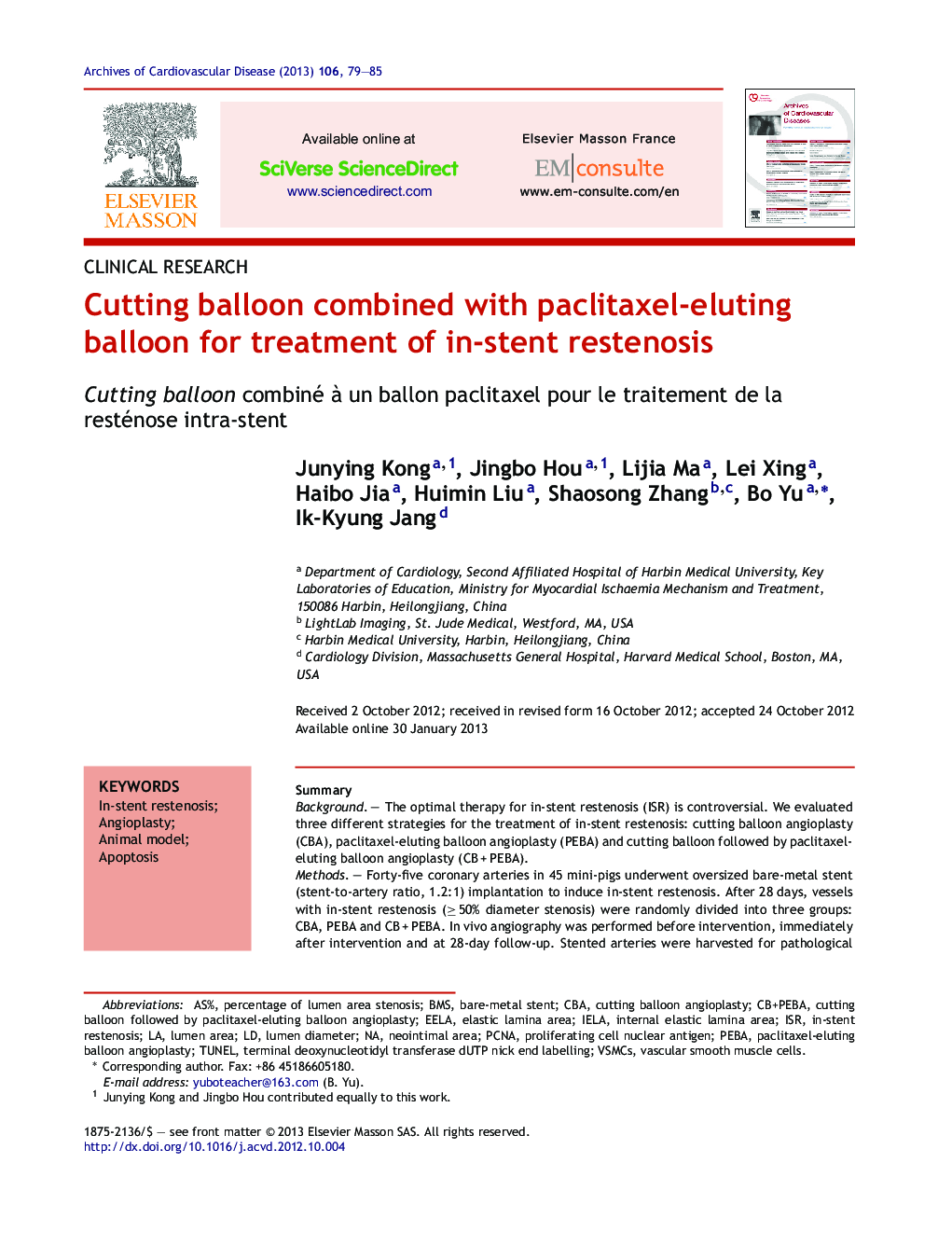| کد مقاله | کد نشریه | سال انتشار | مقاله انگلیسی | نسخه تمام متن |
|---|---|---|---|---|
| 2889121 | 1574367 | 2013 | 7 صفحه PDF | دانلود رایگان |

SummaryBackgroundThe optimal therapy for in-stent restenosis (ISR) is controversial. We evaluated three different strategies for the treatment of in-stent restenosis: cutting balloon angioplasty (CBA), paclitaxel-eluting balloon angioplasty (PEBA) and cutting balloon followed by paclitaxel-eluting balloon angioplasty (CB + PEBA).MethodsForty-five coronary arteries in 45 mini-pigs underwent oversized bare-metal stent (stent-to-artery ratio, 1.2:1) implantation to induce in-stent restenosis. After 28 days, vessels with in-stent restenosis (≥ 50% diameter stenosis) were randomly divided into three groups: CBA, PEBA and CB + PEBA. In vivo angiography was performed before intervention, immediately after intervention and at 28-day follow-up. Stented arteries were harvested for pathological analyses. The proliferation and apoptosis of vascular smooth muscle cells were evaluated by immunohistochemical staining and the terminal deoxynucleotidyl transferase dUTP nick end labelling (TUNEL) assay, respectively.ResultsAcute lumen gain was not different between the three groups. Late lumen loss and neointimal area at follow-up were lower for CB + PEBA compared with CBA but similar for CB + PEBA compared with PEBA. There were no significant differences in proliferating cell nuclear antigen-positive vascular smooth muscle cells and TUNEL-positive vascular smooth muscle cells between the CB + PEBA and PEBA groups.ConclusionsPEBA with or without cutting balloon was superior to CBA alone for in-stent restenosis. The underlying mechanism was probably related to inhibition of smooth muscle cell proliferation and increased apoptosis. In this porcine coronary artery restenosis model, PEBA with or without cutting balloon was superior.
RésuméJustificationLe traitement optimal de la resténose intra-stent reste controversé. Nous avons évalué trois stratégies différentes pour le traitement de la resténose intra-stent : angioplastie avec cutting balloon, angioplastie avec ballon au paclitaxel et cutting balloon suivi d’une angioplastie avec ballon au paclitaxel.MéthodeQuarante-cinq artères coronaires chez 45 cochons ont bénéficié d’une angioplastie par un stent métallique surdimensionné (ratio stent/artère : 2.1) afin d’induire une resténose intra-stent. Après 28 jours, une resténose intra-stent définie comme un diamètre de sténose supérieur ou égal à 50 % de l’artère coronaire ont été randomisés dans trois groupes : angioplastie avec cutting balloon, angioplastie avec ballon au paclitaxel et cutting balloon suivi d’une angioplastie par ballon au paclitaxel. L’angiographie in vivo a été réalisée avant l’intervention, immédiatement au décours et à 28 jours. Les artères stentées ont été prélevées pour analyse anatomopathologique. La prolifération et l’apoptose des cellules musculaires lisses vasculaires ont été évaluées par immuno-histochimie et par un marquage terminal deoxynucléotidyle transferase d’UTD (marquage TUNEL), respectivement.RésultatsLa réduction immédiate de calibre coronaire n’était pas différente dans les trois groupes. La réduction tardive du diamètre luminal et la surface néo-intimale au suivi était moindre dans le groupe cutting balloon suivi d’une angioplastie avec ballon au paclitaxel, comparativement au groupe angioplastie par cutting balloon mais similaire au groupe angioplastie par ballon au paclitaxel. Il n’y avait pas de différence significative dans la détection de prolifération de cellules musculaires lisses vasculaires par reconnaissance antigénique ou par le test TUNEL, entre le groupe cutting balloon suivi d’une angioplastie par ballon au paclitaxel et le groupe angioplastie par ballon au paclitaxel.ConclusionL’angioplastie par ballon au paclitaxel avec ou sans cutting balloon s’avère supérieure à l’angioplastie par cutting balloon seule pour la prévention de la resténose intra-stent. Le mécanisme est probablement lié à l’inhibition de la prolifération des cellules musculaires lisses vasculaires, et une augmentation de l’apoptose. Dans ce modèle porcin de resténose coronaire, l’angioplastie par ballon au paclitaxel avec ou sans cutting balloon s’avère supérieure aux autres méthodes testées.
Journal: Archives of Cardiovascular Diseases - Volume 106, Issue 2, February 2013, Pages 79–85